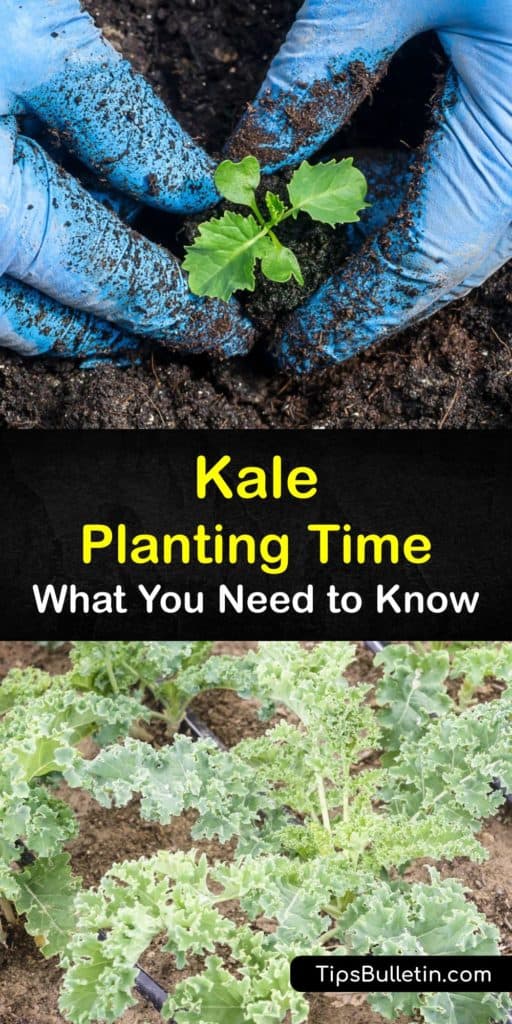Out of all the superfoods, kale is one of our favorites. We love tossing it in a garden salad, sauteing it with garlic and mushrooms for stir fries, and adding it to green smoothies. It’s even better when it’s fresh. Learn how and when to plant kale in your own home garden.
Kale plants are from the Brassica family, like Brussels sprouts and cabbage, and they are cool-season crops of the Acephala group that grow just about anywhere with the right conditions. There are many types of kale, from Red Russian, Lacinato, Dwarf Blue, and Dinosaur kale to Vates, Redbor, and Winterbor kale, and they are all easy to plant and harvest for the dinner table.
Like chard and spinach, kale or collard greens leaves are highly nutritious and packed with vitamin C. It improves heart health while protecting against many diseases and is a great addition to your diet. It’s also the perfect leafy green for growing at home in a garden bed or container.

Planting and Growing Kale
Learn when to plant kale seeds indoors and outside when the temperatures are just right. Discover how to care for your plants as they grow and harvest the kale leaves for preparing a healthy dish.
When to Plant Kale Seeds
If you’re wondering when to plant kale in zone 5 and lower, it’s a good idea to start them indoors when the temperature outside is still chilly. Find out when to plant kale seeds indoors in cold regions for the best germination.

Kale Seed Planting Time
If you live in a northern region between zones 3 and 5 and want a head start on the growing season, starting seeds indoors before the last frost is the way to go. This gives the plants time to germinate before transplanting them outside in the garden bed or containers after the last frost date.
If you’re unsure when to plant kale in zone 6 and up, keep an eye on your weather. Sow seeds directly in the garden when the temperatures are above 55°F, preferably between 60 and 70°F.
It’s also possible to sow seeds in late summer or early fall for harvesting before the fall frost. Early spring and fall planting gives you two opportunities to grow and harvest fresh kale as long as you pick the leaves before the first frost.
How to Grow and When to Plant Kale
If you live in a warmer area, it’s safe to plant kale outside anytime that the temperatures are above 55°F. Here is how and when to plant kale seeds directly in the outside garden.
Southern regions have warm temperatures and mild winters, and it’s often challenging knowing when to plant kale in zone 7 and higher or when to plant spinach in your zone.
Kale does not like growing during hot summers, so the best time to plant different kinds of kale or the best time to plant Swiss chard in these regions is early spring or late fall. Biennial types like Red Russian kale produce edible leaves through the winter.
Prepare the garden bed or container by amending the soil with compost and fertilizer. Choose an area in the garden or pot where the kale gets six hours of full sun with some partial afternoon shade. When starting kale from seed, sow the seeds a half-inch deep in the dirt with 12 to 24-inch spacing and water them right after planting.
Caring for Your Plants Through the Kale Growing Season
Kale is a fast-growing plant that needs little attention to grow. However, they still require occasional TLC to thrive. Here is how to care for your plants throughout the kale growing season and problems to watch for as they grow.
Kale is a fast grower that desires an inch to an inch and a half of water each week, and regular watering is necessary during dry spells. Spreading mulch over the bed helps retain moisture while preventing weed growth.
Aphids, cutworms, cabbage worms, flea beetles, and cabbage loopers are common pests that plague kale plants. These insects feed on the kale seedlings, roots, and individual leaves, and an infestation ruins an entire crop.
A great way to deter cabbage worms and cabbage loopers is to install row covers. These covers are also ideal for protecting your plants from the hot sun and cold temperatures. To kill other garden pests and get rid of little green bugs on kale, remove the bugs by hand and use insecticidal soap if necessary.
How to Use Kale to Make Pesto
It’s the end of the kale growing season, and you harvest kale leaves on a daily basis. While there are countless ways to prepare these leafy greens for eating, using kale as a substitute for basil is a unique way to use leaves for something a little different.
After you pick kale leaves and wash and chop them, place the garlic clove and pepitas in a food processor and pulse them to grind up the pepitas. Add the Parmesan cheese, salt, and pepper to taste and pulse again before adding the kale and lemon juice. Run the processor and drizzle in the olive oil to finish combining the mixture.
Give the pesto a taste. If it’s too bitter, consider adding a quarter-teaspoon of maple syrup or honey to sweeten it. Pour the kale pesto into a storage container and store it in the refrigerator. Toss it with pasta, add it to a bowl of soup, slather it on a sandwich, or spoon it over a frittata.
Leafy greens are easy to grow at home, and kale is always our top choice when preparing a new garden in early spring. The key to healthy kale production is remembering that this cabbage family member loves growing during cool weather.

Now that you understand when to plant kale to produce a healthy crop of leafy greens, why not share our kale planting guide with the vegetable-lovers in your life on Facebook and Pinterest?